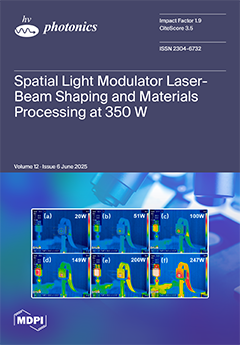Objective: This in vitro study evaluated the effectiveness of three laser systems—diode, CO
2, and Er:YAG—for debonding composite attachments used in aligner orthodontic therapy. Materials and Methods: Fifty extracted human premolars with composite attachments were divided into five groups (
n =
[...] Read more.
Objective: This in vitro study evaluated the effectiveness of three laser systems—diode, CO
2, and Er:YAG—for debonding composite attachments used in aligner orthodontic therapy. Materials and Methods: Fifty extracted human premolars with composite attachments were divided into five groups (
n = 10): control, RT (rotary tools), diode laser (980 nm, irradiance was 4811 W/cm
2), CO
2 laser (10.6 µm, irradiance 1531 W/cm
2), and Er:YAG laser (2940 nm, irradiance 471.7 W/cm
2). Shear bond strength (SBS) testing measured debonding forces. Enamel surface changes were evaluated using micro-CT, optical profilometry, and stereomicroscopy. The Adhesive Remnant Index (ARI) assessed residual bonding material. Results: Laser treatment increased enamel roughness (
p < 0.05). Er:YAG laser caused the highest roughness (Sa = 2.03 µm) and up to 0.17 mm enamel loss but left minimal adhesive remnants and no fractures. Diode laser preserved surface smoothness with moderate bond weakening. CO
2 laser had intermediate effects. RT showed the highest SBS but resulted in greater enamel alteration. SBS was significantly reduced in the laser groups, lowest for Er:YAG (81.7 ± 45.5 MPa vs. control 196.2 ± 75.3 MPa). ARI indicated better adhesive removal in the laser-treated groups, with Er:YAG showing the highest percentage of clean enamel surfaces (67% vs. 25%). Conclusions: Er:YAG demonstrated the best balance between effective debonding and enamel preservation. Diode and CO
2 lasers also offer viable alternatives to rotary tools. Further clinical studies are recommended.
Full article





